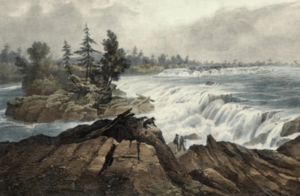
Photo Credit: https://anishinabeknews.ca/2015/06/10/development-on-the-chaudiere-falls-no/
Here in Canada, June is Indigenous History Month. But we recognize our Indigenous brothers and sisters every day. OWL Rafting, our proud third-generation family-owned business, has been hosting adventurers of all ages on the stunning Ottawa River. We recognize the deep and inherent connection between the Kitchisippi – the Ottawa River – and the Algonquin peoples who have called this place home since time immemorial. We’re grateful for their enduring legacy and how it enriches our daily lives. So, come along with us as we journey through the Indigenous history of the Ottawa River. Together, we’ll gain a deeper appreciation for this beautiful region and the stories it holds. Let’s discuss:
1)Ottawa River History
2)The Algonquin Nation
3)Canoe Culture
4)Sacred Sites & Spiritual Connection
5)Honouring Indigenous History Month
The Ottawa River: A Historical Lifeline
The history of the Ottawa River is deeply intertwined with that of the Algonquin people. Known as “Kitchissippi” meaning the “big river” or “grand river” in Anishinaabemowin, the Algonquin language, this mighty river is the “main artery” of Algonquin territory, with their homelands encompassing all of the Ottawa River watershed. Flowing through unceded Algonquin territory, the Kitchisippi has always been a vital transportation route for trade and travel, a gathering place for ceremony and celebration, and a rich source of sustenance for thousands of years. The Algonquin people are the original stewards of this land.
The Kitchisippi has long been a gathering place for Algonquin peoples and numerous other indigenous nations who have paddled these waters.
The Algonquin Nation
The Algonquin people have a rich history and deep connection to the Ottawa River watershed, dating back at least 12,000 years, with oral traditions stating their presence since time immemorial. Their ancestors were semi-nomadic hunter-gatherers who used birch bark canoes for transportation and relied on the rivers for hunting, fishing, and gathering.
European contact began in 1613 with Samuel de Champlain, leading to significant changes and challenges for the Algonquin people. The fur trade, initiated in the 1530s, and the subsequent Beaver Wars (1640-1701) brought conflict and displacement. Despite hardships, the Algonquins maintain their cultural heritage and connection to the land.
- Sources:
Canoe Culture
Since time immemorial, birch bark canoes have played a fundamental role in the lives of Algonquin people. The canoe enables them to travel extensive distances and connect their communities. However, the continued impacts of colonization have led to an interruption in their relationships with this ancestral craft. They are (re)connecting and (re)learning knowledge and practices, including how to build a birch bark canoe. A canoe is built in ceremony and with intention.
At OWL Rafting, we pay homage to this rich canoe culture by sharing the Algonquin people’s travel routes with our guests – but in a different craft; a raft designed for big whitewater.
Sacred Sites & Spiritual Connection
The Ottawa River is home to many sacred sites, deeply revered by Algonquin communities for their cultural and spiritual significance as meeting places, portage sites, and trade routes.
Chaudière Falls: The Chaudière Falls, best known as Akikpautik, and Islands have been a sacred meeting place for over 5,000 years, predating the Great Pyramid and Stonehenge. Samuel de Champlain witnessed Algonquin ceremonies here in 1613. The area, in Algonquin territory, was a neutral meeting place where people from vast distances would gather peacefully, leaving their weapons behind. This tradition ended with European settlement and industrialization.
In 1908, the Ring Dam submerged the Chaudière Falls, once a major tourist attraction. Ottawa’s bid to become Canada’s capital included paintings of the Falls, influencing Queen Victoria’s decision. Prime Minister Mackenzie King’s 1950 Master Plan for Ottawa envisioned restoring the Falls as a central park. The National Capital Commission, established in 1958, implemented these plans, purchasing industrial land to free the shoreline.
Algonquin leader William Commanda advocated for undamming the Falls, creating parkland, and establishing an Indigenous peace and healing center, a vision supported by many and recognized by the Order of Canada. Work is still being done to restore this sacred place.
Oiseau Rock: This site is located along the Ottawa River near Sheenboro, Quebec. This towering rock face rises over 150 meters above the river and features ancient pictographs created by Indigenous peoples. These pictographs, painted in red ochre, depict various symbols and figures, believed to have been created for spiritual and ceremonial purposes. Oiseau Rock is a testament to the deep spiritual connection Indigenous peoples have with the land and the river. It served as a place of vision quests, where individuals sought guidance and spiritual insight.
Important Note: INTERACT RESPECTFULLY WITH INDIGENOUS LANDS. Visitor activity can create additional challenges or increase vulnerability for the Indigenous community you are visiting. Wildfires, stranded or injured backcountry visitors, and increased pollution of waters and lands place extra strain on Indigenous communities and resources. If you can’t keep away, please enrich your experience by developing your respect for the water, plants, and animals that have sustained the people for millennia. Take direction for your adventure and wildlife experience from local Indigenous guides.
Honouring Indigenous History Month
This Indigenous History Month, we invite you to join us in honouring the profound history and culture of the Algonquin peoples along the Ottawa River. Whether navigating the rapids or enjoying the serene beauty of the river, take a moment to reflect on the deep connections between the land, water, and the Algonquin communities who have cherished this region for generations.
Are you interested in learning more about the Indigenous history of your current homelands? Here’s a good resource >
Note: Dear reader, We welcome your feedback. We recognize the profound distortions and omissions that have characterized indigenous history. If you have any suggestions for improvement or any pertinent information to contribute, contact us. We are committed to making necessary revisions to ensure accuracy and respect.
We would like to give a very special thank you to Waaseyaa Consulting for sharing their knowledge and insightful perspective on this topic.